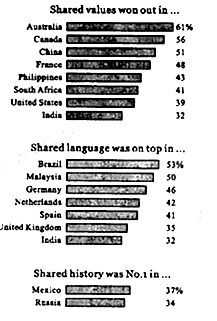31. A. trees B. bushes C. woods D. grasses
32. A. stream B. rock C. tree D. house
33. A. found B. sensed C. heard D. smelt
34. A. at B. through C. in D. onto
35. A. terrible B. strange C. pleasant D. familiar
36. A. missed B. discovered C. followed D. ignored
37. A. calmly B. loudly C. merrily D. gently
38. A. searched B. wandered C. looked D. travelled
39. A.window B. girl C. house D. hero
40. A. satisfaction B. disappointment C. embarrassment D. delight
41. A. jumped B. climbed C. walked D. flew
42. A. awake B. abandoned C. available D. asleep
43. A. spotted B. watched C. observed D. saw
44. A. disturbed B. comforted C. rescued D. scared
45. A. pain B. shock C. sorrow D. relief
第二部分:阅读理解(共两节,满分40分)
第一节(共15小题;毎小题2分,满分30分)
阅读下列四篇短文,从每小题后所给的A、B、C、D四个选项中,选出最佳选项,并在答題卡上将该选项涂黑。
A
What brings a nation together? Of the four choices — shared values, language, history, and religion, it’s shared values. In our latest poll (民意调査), seven out of 16 countries chose values as the greatest factor (因索)bringing a nation together, and six preferred language. Both choices scored high in the poll, suggesting that our values and how we express them are closely linked Still, history was not forgotten in some countries, particularly in Mexico and Russia. Even Canada and the United States chose national histories as the second-most important factor uniting their people. The biggest surprise? Not one country picked religion as its top choice.

| 陕西高考语文试题 | 陕西高考数学试题 | 陕西高考英语试题 | 陕西高考理综试题 | 陕西高考文综试题 |
| 陕西高考语文答案 | 陕西高考数学答案 | 陕西高考英语答案 | 陕西高考理综答案 | 陕西高考文综答案 |